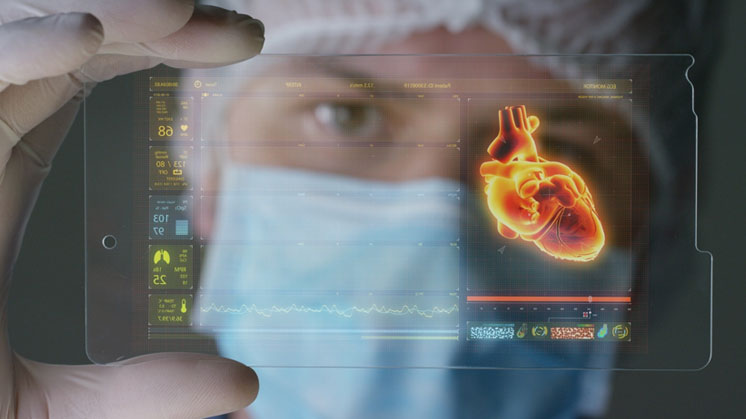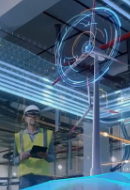What is Augmented Reality?
Augmented Reality: The real world with different eyes
Augmented Reality (AR) is a technology that allows virtual elements to be superimposed onto our vision of reality. Increasingly more in demand, this technology’s development in recent years has been exceptional.

The term was coined in 1992 by scientist and researcher Thomas P. Caudell during the development of one of the most famous aircraft in the world: the Boeing 747. Caudell observed that workers in charge of assembling the new aircraft lost too much time interpreting the instructions and thought, "What would happen if they had access to a screen that could guide them through the installation"? The invention did not succeed, but the concept of Augmented Reality (AR) was born at that precise moment.
The concept emerged then, not in Summer 2016, as many of us believe, when the world came down with Pokémon GO fever, a video game that consisted of searching for and capturing various characters from the Japanese saga which, at its peak, hit the astronomical figure of 28.5 million active daily users.
Pokémon GO popularised AR by bringing it closer to the general public, , to all of the public really, but many other games have taken advantage of it in recent years, like Mario Kart. The ultimate goal is to make it more fun for the player and to encourage a more immersive experience.
In the past, companies from a variety of industries (healthcare, education, architecture, services, retail, etc.) were already using AR to create valuable experiences for their customers beyond mere entertainment.
Ten augmented reality applications
In 2024, AR applications are as innumerable as they are surprising: They are able to let us know the architectural style of a building located in front of us, bring to life a Monet painting, visualise a patient's report of a patient undergoing operation on another plane, and so much more. If you are a little familiar with these, don't miss any of the following examples of Augmented Reality:
10 augmented reality applications
In 2024, AR applications are as innumerable as they are surprising: They are able to let us know the architectural style of a building located in front of us, bring to life a Monet painting, visualise a patient's report of a patient undergoing operation on another plane, and so much more. If you are a little familiar with these, don't miss any of the following examples of Augmented Reality:

Do you know what utilities Augmented Reality has?
- Surgery in detail: through tablets or holographic glasses, doctors can visualise organs in 3D or consult the patient's history before or during a surgical intervention.
- Custom cars: more and more car manufacturers are offering their potential buyers the possibility of visualising their future car and adapting it to their tastes and needs.
- Lessons that come to life: many students are already benefiting from notebooks that utilise special markers which react to being placed in front of a computer screen or a mobile device offering 3D images.
- Attention athletes! Runners, cyclists, mountaineers and hiking enthusiasts can now explore their routes in 3D by projecting them into any surface. This allows them to plan their next adventures and share their activities.
- Instant translations: perfect for travellers. Just take a picture of any text in front of you (a report, advertisement, recipe, etc.), and get an instant translation.
- Facial scanners: it sounds like science fiction but there is already a service capable of recognising a person's face and simultaneously showing the social networks in which he or she is active.
- Smart architecture: many companies use AR to enable clients to check in real time how their house will look once the work is completed or how a new armchair will fit in with the rest of the decor.
- Perfect for advertising: from trying on clothes virtually to watching an interactive campaign on a wall in the middle of the street, the sales and promotion potential offered by AR to brands is incalculable.
- The universe brought closer: by focusing your mobile device's camera to the sky, you will be able to identify stars, constellations, planets and other celestial bodies, in addition to receiving extra information about them.
- Designed for NASA: we continue to climb heights... Using smart glasses, astronauts now have the technology they need to receive visual instructions in case they have to make repairs during their expeditions.
AR has not gone unnoticed by the great tech giants. By using glasses, smartphones, and tablets — the latter two being boon allies to AR — they compete amongst themselves to invent the platform, the toolkit, the wearable device, or the app that ultimately reels us all in.

Digital transformation
Digitalisation is an indispensable ally to overcome the challenges in the current context.

What is Artificial Intelligence?
AI is about creating machines that have the same capabilities as humans.

Machine Learning
Discover the main benefits of Machine Learning.

Learn more about PERSEO
PERSEO aims to facilitate access to the technologies and businesses of the future.
Differences between augmented reality and virtual reality
Despite being two sides of the same coin, these two technologies represent two different revolutions. While Virtual Reality allows you to create a virtual world from scratch (with everything you could possibly want to shape a fantasy world), what Augmented Reality does is add virtual elements (additional information in the form of graphics or images) to our real environment.
Apple CEO Tim Cook is very clear on this point: "Augmented Reality [AR] is larger than Virtual Reality [VR] because this gives the capability for both of us to sit and be very present talking to each other, but also have other things visually for both of us to see. It will be the next revolution, as was the smartphone during its time."
Today, the scope of AR in both work and personal environments is unquestionable. However, the question is: Will there be 'another Pokemon GO' that will cement the future of this technology?















